[Post based on volumes one, two, and three.]
Shojo FIGHT! lives up to its name as it shows girls fighting—on and off court. They’re fighting against friends as well as enemies. They’re fighting for love just as much as they are fighting for victory, and they’re even fighting for their friend’s freedom. Oishi Neri and her soon-to-be friends take on their senpai in intra-squat games, but they also go head-to-head with a dangerous organization that puts their high school education at risk. Even though their lives are connected through volleyball, the girls and boys are so preoccupied with the emotional turmoil and the physical intimacies teenage life brings that they hardly think about ‘aiming for the top.’ And yet, standing on the court, these girls fight with everything they’ve got.
[Beware! This text contains spoilers!]
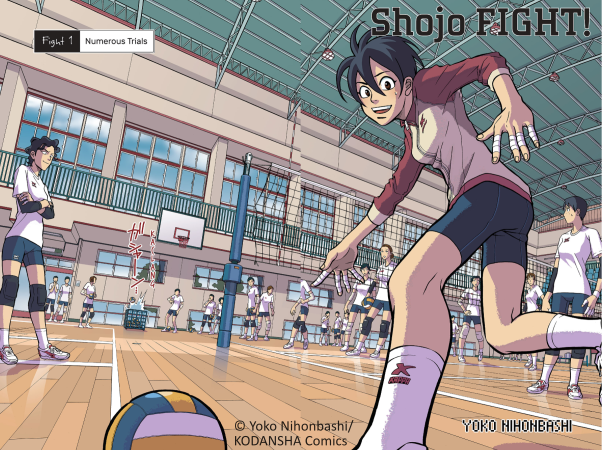
Love And Volleyball
Before I dive into Shojo FIGHT!, let me give you a very short intro about how I go about preparing for a post. After I’ve decided on a certain piece, I take notes while reading (or watching) it, like the characters’ development, the progress of the story, recurring themes, or things that strike me as funny, peculiar, or stupid. Once I’ve finished, I read through my notes and group them by topic to get a tentative structure for the post. Why am I telling you this? Well, because when I went through my notes on Shojo FIGHT!, I made an interesting discovery. The first topic I added was “boy/girl relationship.” Besides conversations about relationships, this category also included intimacies like kissing and sex (real and rumored), other forms of physical contact, and the behavior of boys and girls when it came to love and desire. The notes on this topic kept growing and growing, and, surprisingly, it turned out to be the longest one. The category ‘volleyball’ ended up being miserably meager.
This already tells you that the focus of the first three volumes of Shojo FIGHT! isn’t so very much on volleyball, even though the covers are adorned with ready-for-action female volleyball players. Rather, the manga is about the diverse personal challenges and interpersonal relationships between the teenagers. Of course, there are training sessions and some matches, too, but for the competitive volleyball action to pick up, I had to wait until the second half of volume three. Even then, it was (once again) more or less an intra-squad fight. Anyway, let’s start and see what this volleyball-sprinkled girls’ story is all about.
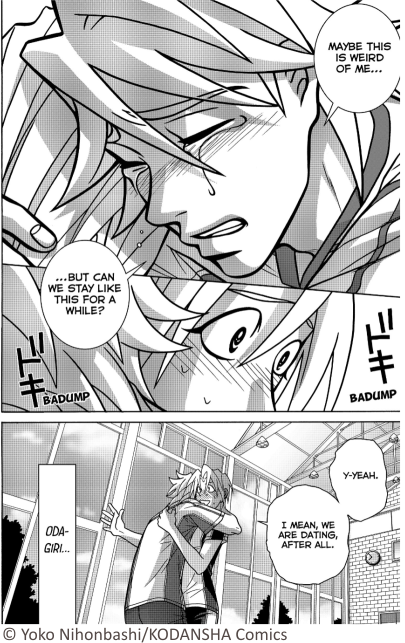
The Mad Dog
The manga begins in the out-of-play area of the Hakuunzan Middle School volleyball court, where the protagonist, Oishi Neri, smiles gleefully as she picks up stray balls from the players who are busy with practice. Despite being a third-year student, Neri is tasked with first-year duties like cleaning up after practice and doing the laundry. Before you’re overcome with pity, let me tell you that this was Neri’s choice. She voluntarily hid her outstanding volleyball talent to prevent her aggressive side from coming to light. As a precautionary measure, she even forbade herself from making friends again. Neri’s a bit too hard on herself, if you ask me. But then again, she’s still haunted by the bitter experience of being rejected by her teammates at the elementary school volleyball club because of her temper: “Everyone was probably just sick of playing with you.”
However, as the main character, Neri had to play at some point. So, halfway through chapter one, a single incident puts her back on the court. Additionally, we get to witness her aggressive behavior for the first time. When she tried to protect her precious necklace from the groping hands of a teammate, she bent the attacker’s finger backwards while issuing crude words of warning: “Hands off, bitch.” In order to hold Neri accountable for her actions, the coach decided that she would have to take responsibility by stepping in for the injured player in the upcoming match.
Plagued by her past and trying to avoid a relapse, Neri has so far successfully avoided playing with others. Understandably, she wasn’t happy. Despite her efforts to control her aggressiveness on the court, when the heat of the game took hold of her, she fell back into her old, bossy habits.

Because of this behavior, Neri has been called a “mad dog,” “a wolf in sheep’s clothing,” or “a volleyball elitist.” Occasionally, she’s called herself an “ass.” Despite this colorful selection, the name I would’ve chosen for her is queen of the court. Wanna know why?
The Queen Of The Court
A certain young male athlete from another manga (and anime) also expresses his passion through aggression. He, too, is a volleyball prodigy and was, by the end of middle school, spurned by his teammates for his dictator-like behavior. When he started high school, he, too, was more or less forced to join a school with a small, low-ranking volleyball team. Yet, there he found teammates who accepted him the way he was and a cheerful partner who wanted him to go all out. In the end, he realized that it’s ok to be bossy because what made him “king of the court” also turned him into an incredible athlete. Do you know who I’m talking about? Of course, there is only one “king of the court,” namely, Kageyama Tobio from Haikyuu!!.
When Neri moved on from middle to high school, she, too, was more or less left with no other choice than to join Kokuyodani High School, a school with a small volleyball team and known for taking on students who couldn’t get in anywhere else. There, despite her best efforts to avoid friendships, she was befriended by Odagiri Manabu, Neri’s groupie-in-secret. Odagiri’s bright and positive attitude reassured Neri that she’s fine the way she is. Actually, her high school teammates, too, wanted her to go wild on the court: “Unleash the mad dog within you!” Noa told her. And when the freedom of one of her teammates was at stake, she had no other choice.

We’ve advanced a little too far on the timeline, so let’s go back to where Neri’s story starts. And that’s when she was splashing around in the bathtub as a baby with the neighbor’s baby boy, who was about one year older, Shikishima Shigeru.
The Osteopath's Touch
Before you complain that I went too far back, let me tell you that Neri’s and Shigeru’s innocent splish-splash in their earliest years is relevant for their present lives. How come? Well, having shared a bathtub with Neri and having seen her naked when she was a chubby baby gave Shigeru a free pass to touch her whenever they were alone. Although, now, as a mature, (roughly) 17-year-old and as an osteopath-in-training, he also has a professional interest in ensuring Neri’s physical health. So, after she collided with a teammate during a volleyball game, he dragged her into the men’s toilet to administer first-aid treatment on her back. His hands must work wonders because Neri couldn’t resist his touch. Her moans emitting from the toilet cubicle led those who arrived on the scene to assume the worst (Neri’s coach) or the best (Shigeru’s friends). As readers, we get a peek behind the door, which allows us to judge for ourselves what to make of the situation.

The alleged ‘toilet-sex’ caused an uproar, and naturally, the coach called Neri’s father to complain about her shameless behavior. The father was enraged by the coach’s accusation and gave him a hefty piece of his mind: “Ain’t no way in hell Shigeru-chan would pull that kinda shit with Neri, you old blowfish! Why, I been putting them in the bath together myself since they were babies!” Besides the missing causal connection between these two events, I wondered why he defended Shigeru’s high morals so fervently instead of his daughter’s. Maybe the father assumed Neri will succumb to Shigeru’s advances should the young osteopath wish to exploit the effects of his touch on her.
But we need not fear, because the mangaka, Nihonbashi Yoko, designed this young man’s character in a way so that no one could ever call him horny and unscrupulous or accuse him of lewd motives. On the contrary, Shigeru seems almost like a saint. He’s an obedient son, he gives money, advice, and support most generously, and he cares for others without regard for himself. His conduct towards the girls is in stark contrast to that of his volleyball teammates, who surrender to the tide of male hormones surging through their veins. Thanks to Shigeru’s saintly nature, putting him in charge of the volleyball girls’ physical well-being at his high school (in his new function as coach) seems almost harmless. Almost…
The New Coach
The events in Shojo FIGHT! unfold in a convenient and rather predictable way. The injury to her back due to the collision in the previously mentioned game prevented Neri from studying and going to school. Instead, she dedicated herself to vigorous cleaning of her parents’ bathhouse. Who knows, scrubbing the floors might have been more beneficial for her back than hitting the books. Anyway, thanks to her outstanding volleyball talent, Kokuyodani High School was willing to accept her without testing her academic knowledge. And, as you might have guessed, Kokuyodani is the school where Shigeru had just been appointed the coach of the girls’ volleyball team as punishment for the ‘toilet-sex incident.’
Putting a high schooler who allegedly had sex with a middle school girl in charge of a bunch of female athletes his age and entrusting him with their physical well-being might not be the best decision an educational facility could make. But don’t forget, it’s the virtuous Shigeru we’re talking about, which, I suppose, should make this decision easier to swallow—for the readers in any case. The girls weren’t thrilled about the idea of a man being privy to intimate details about their bodies. However, the protest was in vain, because the head coach, Jinnai Fueko, let the girls know that “Whoever doesn’t like it can quit the club.” It was a ‘smart’ choice by Nihonbashi-sensei to place a woman in the dictator’s position. That manages to shut down even the most fervent feminist protest. But what about Shigeru? Naturally, he willingly accepted the punishment without hesitation. But he only did so to follow his true calling, which was to save Neri from death!
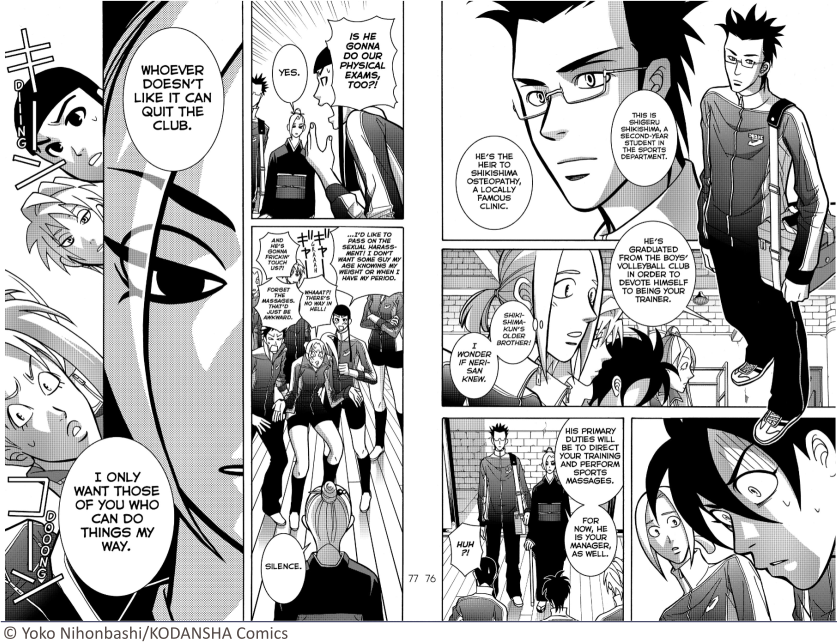
The Lifesaver
Early in the series, we learn about Neri’s older sister’s tragic death. Mari was an outstanding volleyball player, and playing for Kokuyodani High, her team made it all the way to the finals in the spring tournament. Sadly, Mari was hit by a car on her way home from the semifinal and as a result lost her life. At first, Neri blamed herself because her sister died trying to fulfill a promise: to get ice cream for Neri on the way home. Of course, we all know that Neri can’t be blamed for what happened to her sister. So, it must be the car driver’s fault, assuming that Mari didn’t jump out onto the street while the pedestrian light was red, right? Wrong! The real villain in this side story is overexertion! Mari pushed herself too hard during the game and ended up with an injured leg. As a result, she wasn’t able to dodge the approaching car.
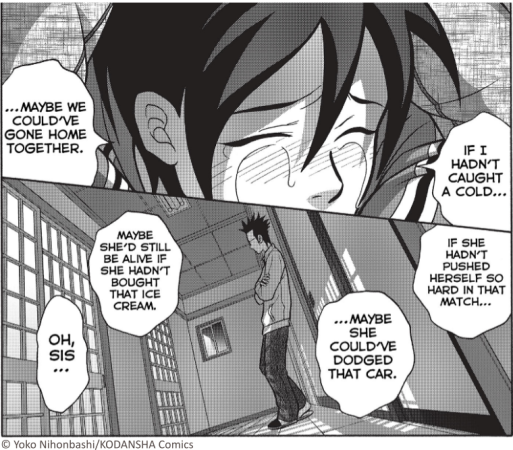
It would be a truly impressive ability if someone were able to dodge a car, even if this person were in prime condition. Of course, it’d be a piece of cake for Damin from the manhwa Infinity. Most likely, though, Neri isn’t blessed with Damin’s superpower. And this causes Shigeru’s brow to (slightly) furrow in concern and worry. Despite his seemingly passive demeanor, it’s clear that he loves her. And in case some readers were still misled by Shigeru’s otherwise expressionless face, his brother knows Neri is “the one thing he truly wants.” And who’d want their love interest to go dying on them because they couldn’t dodge a car in time because of a sports injury? So, apart from his professional duty to care for Neri’s health in his function as coach, he also had a personal interest in her well-being. And he takes it very seriously: “I don’t intend to let you meet the same fate Mari did.”
Well, I think for now, we’ve had our fill of emotional and physical intimacies, which means it’s time to move on to the next topic: volleyball.
Patience Is A Virtue
When reading the manga, you get the impression that volleyball is everywhere. Volleyball forms the foundation of Neri’s and her sister’s relationship, intertwining every aspect of their lives, from the ice cream to Mari’s injury and even her death. Neri also said that she only practices this sport because of her sister. Her inability to control her sinister side when playing is the reason she refused to make any friends—on and off court—and she’s continuously struggling with herself because of these volleyball-related aggressive outbursts. The (intimate) relationship between her and Shigeru is built upon her volleyball-induced injuries, which require his constant care and attention.
For many other characters, too, volleyball is a means to an end. Odagiri follows her heroine, Neri, to Kokuyodani and also hopes that practical experience will enable her to draw a better sports manga. Nao joined the volleyball team because she wanted to stay with her friend and, in the end, played for love—or money.

So, there’s lots of talk about volleyball, but less action. In volume one, in any case. The first game lasts barely an entire chapter because it’s canceled after Neri’s collision with her teammate. This is a pity because when the girls entered the court, their dedication and passion, as well as their hard-boiled attitude towards their opponents, made the matches captivating and exciting to follow. Famished as I was after the volleyball drought in volume one, I was looking forward to the “exhibition” that was announced early in volume two. This was, in fact, an intra-team ‘receive and pass’ challenge by Kokuyodani’s second-years, which showed the newbies what they were lacking and deterred any potential new club members. As a whole, the competition was interesting, and it also helped to get to know the new characters.
The sports action picks up in volume three when the competition moves underground, onto the dangerous terrain of the high school volleyball gambling ‘mafia.’
Undercover
How do a bunch of 15, 16-year-old high schoolers get dragged into a dangerous and illegal gambling ring? I’ll give you the short version. Nao, a member of the Kokuyodani volleyball club, fell in love with the head of this criminal underworld organization that “puts amateur players in skimpy outfits and pits them against each other.” She disappeared from high school volleyball but resurfaced as a player at the volleyball gambling event. Naturally, her friends rushed to free her from this precarious situation. By the way, the head of this sizable undertaking is the organic food enthusiast and Haizawa High School boys’ volleyball club member, Honma. I must say that I’m very impressed by Honma’s organizational competence. It’s no small feat to organize such an illustrious and, simultaneously, illegal and top-secret event.
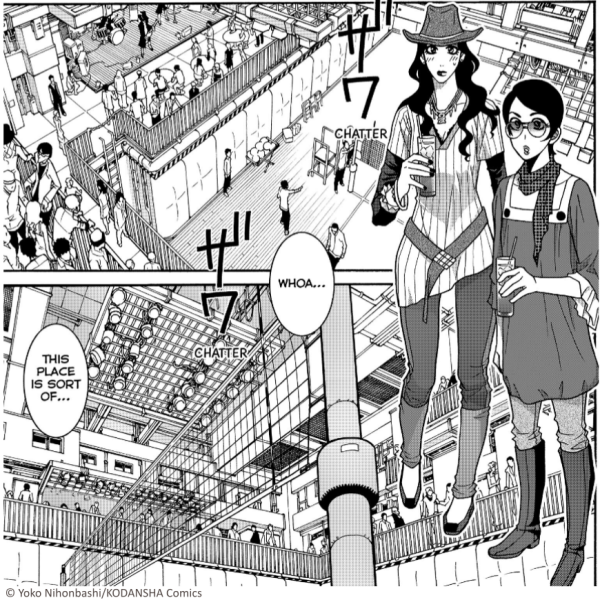
The elaborate build-up leading to the game that decides over Nao’s freedom takes up the first half of volume three and involves Michiru (Shigeru’s younger brother) activating his assets to find Nao. He then infiltrates the dangerous organization as a waiter who has more free time on his hands than the teenager organizing the event. Disguised as part of the audience, the first-year girls go undercover by dressing up and wearing makeup. In the end, though, they have to go head-to-head against the event’s unbeaten team, the Russian Roulettes, to free Nao from the clutches of the evil Honma (even though she joined willingly). Should the girls beat the ‘Russians,’ the team would be disbanded, and Nao would be free to leave. In a surprise development, the overpowering Kokuyodani second-years play for the Russian Roulettes—also to free Nao. Kokuyodani’s captain made a deal with Honma, where he promised he would let Nao go should the ‘Russian’ girls win. Wow! What a pickle! Who should you root for now?!

The game contains plenty of tension and drama and was gripping enough to keep me curious about how things were going to play out. I don’t want to spoil the outcome of the match, but let me tell you that much: Honma, the head of this dangerous and illegal volleyball betting ring, isn’t evil at all but actually offers ‘washed-up’ volleyball amateur players a place to practice the sport they love. And he even helped Nao improve her volleyball skills. The bad guy turns out to be a good Samaritan! If this isn’t a happy ending…!
The most intriguing aspect of the entire volleyball gambling affair isn’t the game itself, but the two names Nihonbashi-sensei chose for the second-years and the team opposing the first-years: the Witches and the Russian Roulettes.
The Witches, The Demon, And The Russians
Especially the name Witches is most likely meant to evoke feelings of nostalgia by reminding the readers of the 1964 Tōkyō Olympics and the gold medal of the women’s volleyball team. The team received the name Oriental Witches (tōjō no majo) or Witches of the East after 22 consecutive wins on their Eastern European tour in 1961. This success was crowned by beating the Russian team and winning the 1962 World Championship. And finally, in 1964 they also took gold at the 1964 Tōkyō Olympics.
However, their success story doesn’t start as a national but as the corporate team of the textile company Nichibō. The ‘maker’ of the Witches, the so-called demon coach Daimatsu Hirobumi, invoked a fighting spirit (konjō) in his players and subjected the women to a harsh training regimen. Daimatsu also developed a new technique, the rolling receive (kaiten reshību). You can see it at the beginning of the brief video clip on 1964 Olympics final’s last minutes. If you want a more detailed look at this technique, you could watch the anime Haikyuu!! The libero Nishinoya is particularly fond of this receive, although he gave it a somewhat flashier name: rolling thunder. Anyway, a quick online search is all you need to do to find this information and learn about the ‘enchanting’ Olympic victory of the Oriental Witches and their demon-coach.
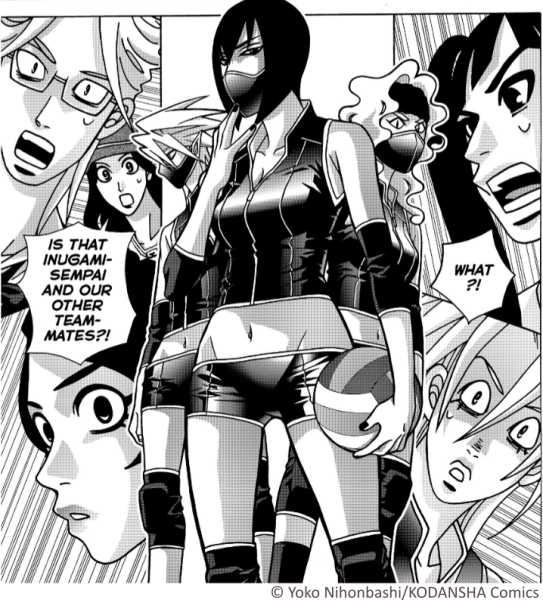
Apart from the name, though, the Witches in Shojo FIGHT! have little in common with Nichibō’s corporate team. Of course, there’s the obvious difference in age and thus in occupation, but the girls in the manga also don’t train under the whip of a demon coach who pushes his players beyond their limits. With Mari’s death and the enduring leg injury of another girl because of excessive strain, as well as Shigeru’s efforts to protect Neri from harm, Nihonbashi-sensei shows us that times have changed…
The 1964 Tōkyō Olympics are generally regarded as symbolizing the economic recovery and the country’s return to the world stage after World War Two. And the Witches were given their ‘role’ in this tale of resurrection. I’m borrowing Christian Tagsold’s words, who wrote: “The story of the Oriental Witches has been often told with a certain degree of elaboration. Leadership, gender, focus on the GNP and technique as a means to overcome ultimate defeat are the backbones of this narrative […]” (Tagsold 2011:451). I only dipped my toe into the pool of literature available, and even this revealed that there’s more to these women’s story than ‘just’ an Olympic victory.
A Content Warning. [The next part contains content about suicide]
I think you’ll like Shojo FIGHT! if you enjoy following teenagers dealing with confusing emotions and amorous encounters. Maybe you’ll sigh nostalgically when you witness the budding of a new love or sigh with relief that you’re already past the age where you made irresponsible decisions. Because all of this happens against the backdrop of a high school volleyball club, it might even remind you of burning wrists and lower arms or bruised fingers. Nihonbashi-sensei dedicates many pages to the emotional and some pages to the athletic development of the characters. Occasionally, she also weaves sociocultural issues into the story, but she does this in such a casual and nonchalant manner that you could almost overlook their gravity.
There’s Akira, Odagiri’s brother. Odagiri only ever talks to him through the closed door to his room, which suggests that he’s a hikikomori. In short, hikikomori is the term for the social withdrawal of young people and adolescents, but also adults. It’s a complex phenomenon and (as far as I’ve found) not unique to Japan. Another issue is Japan’s aging population, which poses a variety of challenges, and Mitsuru mentioned in passing that the educational system, too, is affected by this development.
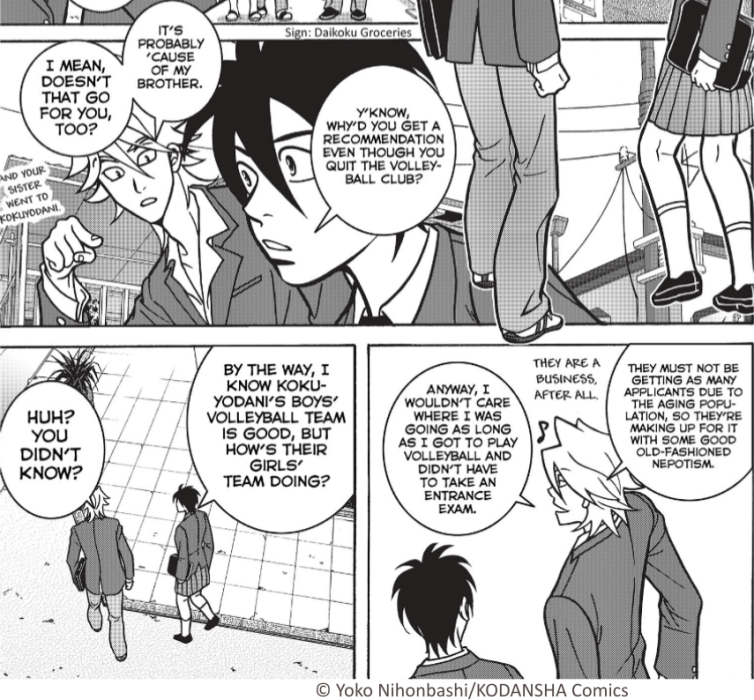
Both topics would offer themselves for a deep dive, but unfortunately, my space here is limited. So, I’m focusing on another matter that was covered hurriedly and superficially: suicide.
I was surprised and shocked that Neri said that she wanted to end her life. Not because I’m used to reading a content warning beforehand, but because I didn’t expect that such a grave topic would be touched upon in an otherwise lighthearted story. Unfortunately, it was dealt with just as lightheartedly. The female coach of Kokuyodani High told Neri that she’d only be able to experience her sisters last hours if she stayed alive to stand on the same court and play at the Nationals. Her first rather lofty and incomprehensible advice is to live like the flowers adorning the grave. I’m no gardener, and giving me a plant is the best way to guarantee its death, so this statement is far beyond my comprehension. The picture search told me that it’s chrysanthemum the coach is talking about, and these flowers are supposed to symbolize longevity and joy (among others). The coach’s second advice to “pull herself out of that hole” might work on someone who’s just had a bad day. I wonder if this encouragement would’ve reached Neri if she had been experiencing serious depression with thoughts of suicide.

More Love And Sex?
After the volleyball gambling game ends, the manga opens up a new thread of intimate relationships and tangled love lives that promise to fill the next volume with elated feelings and heartbreaks. It’s hard to say how many pages will be dedicated to actual volleyball practice or games. If the first three volumes are any indication, the sport might stay in the background until it can be used to spice up the narrative. For me, this isn’t enough incentive to continue reading this manga. But I hope I’ve given you enough detail to decide for yourself if Shojo FIGHT! might be the right manga for you.
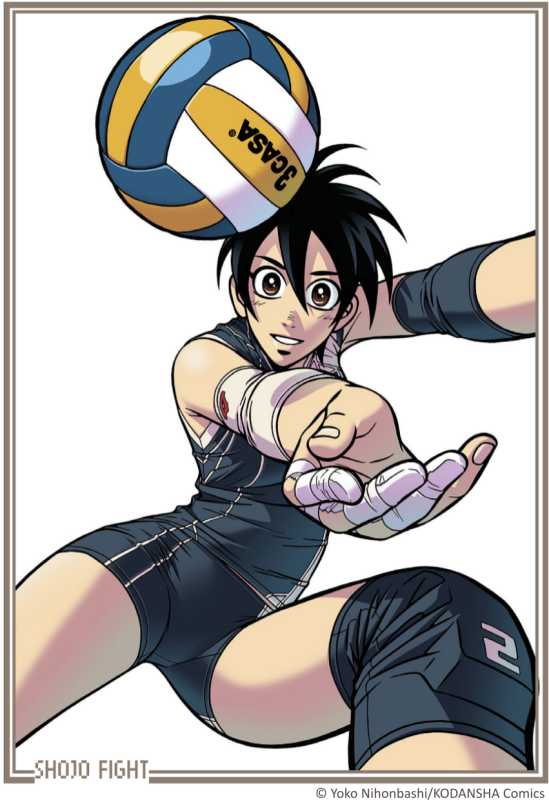
Links:
- Shojo FIGHT (Kondansha Comics)
If you also want to dip your toe into the Witches’ Olympics:
- Christian Tagsold (2011) Remember to get back on your feet quickly: the Japanese women’s volleyball team at the 1964 Olympics as a ‘Realm of Memory’, Sport in Society, 14:4, 444-453.
- Iwona MERKLEJN (2013) Remembering the Oriental Witches: Sports, Gender and Shōwa Nostalgia in the NHK Narratives of the Tokyo Olympics, Social Science Japan Journal Vol. 16, No. 2, 235–250.
- Helen Macnaughtan (2014) The Oriental Witches: Women, Volleyball and the 1964 Tokyo Olympics, Sport in History, 34:1, 134-156.
On hikikomori:
- Hamasaki, Y., Pionnié-Dax, N., Dorard, G. et al. (2021) Identifying Social Withdrawal (Hikikomori) Factors in Adolescents: Understanding the Hikikomori Spectrum, Child Psychiatry Hum Dev 52, 808–817.
- Evelyn Schulz (2022) Hikikomori: Disappearing quietly, Insights LMU München.
Subscribe to never miss a deep dive into the exciting world of sports anime, manga, and manhwa!

